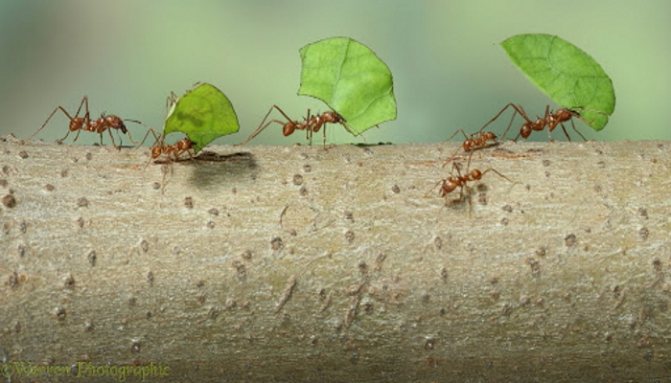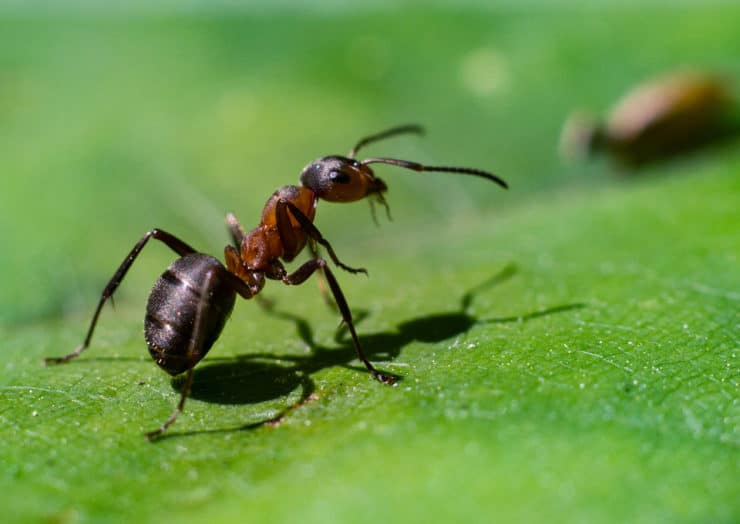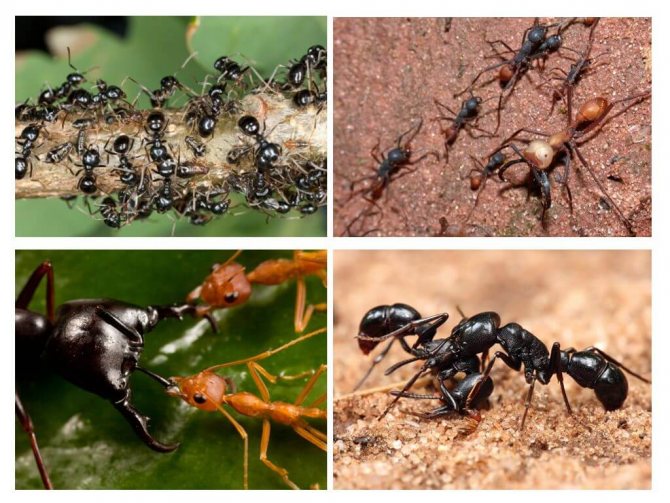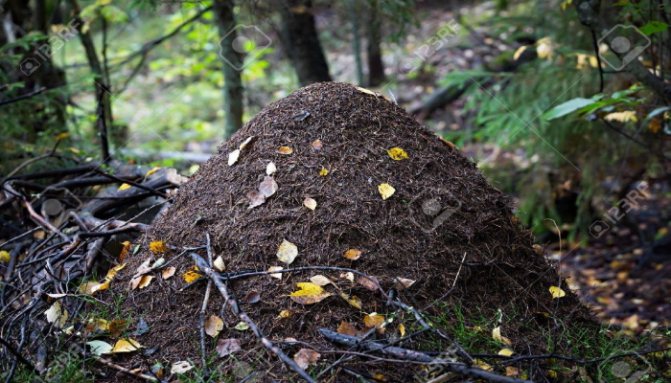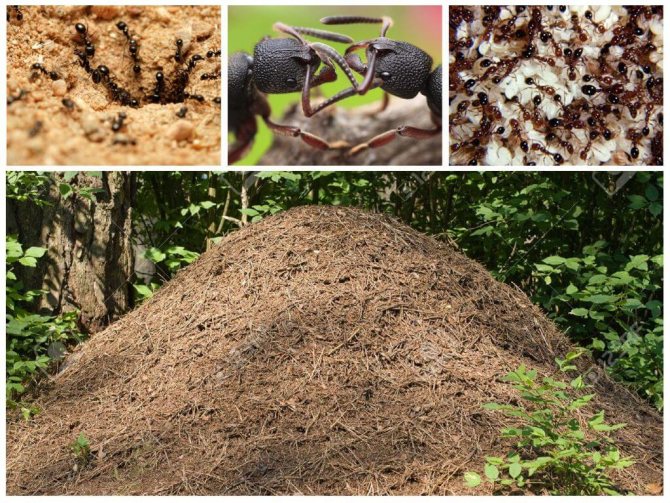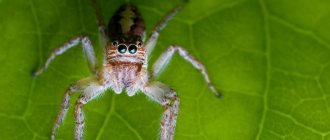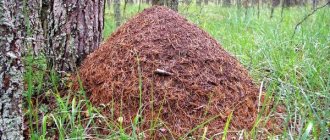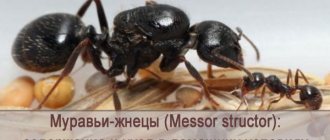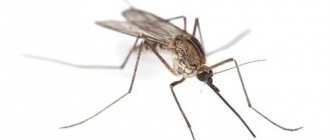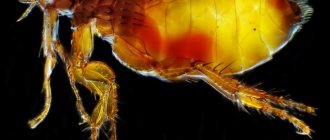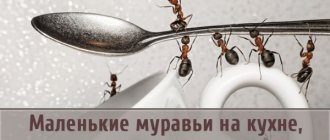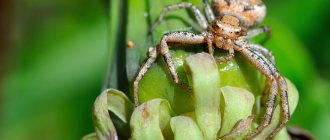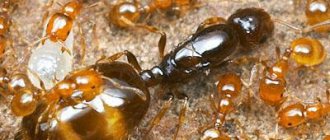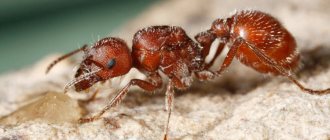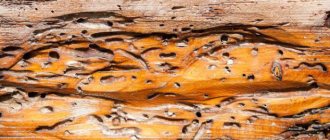Ants are among the most common insects in nature. They can be found in almost any country, in any climate and weather conditions. The only places where they have not yet been recorded are Greenland and Antarctica, as well as some isolated islands in the world's oceans. Ants are social creatures, they cannot exist alone. These insects have their own hierarchy of society, in which each individual occupies a certain place and performs the tasks assigned to it by nature. There is a queen ant, whose main task is to fulfill the reproductive function. Other ants are divided into workers and males. The role of the first is to take care of the family of the anthill, and the second is to procreate.
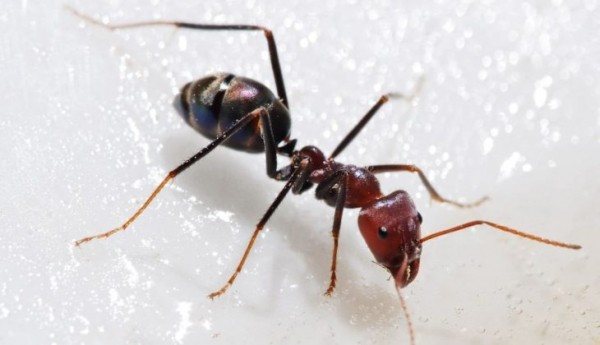
In this article, we will consider the issue of ants' lifespan. Many people are interested in such information exclusively from a general educational point of view, and some people who have encountered ants at home or in an apartment want to know how much they will have to endure this disaster.
Factors affecting the lifespan of ants
In addition to specialization and species, the life span of ants is also influenced by the following factors:
- region of residence;
- the size of the insects;
- the nature of the work;
- specific features.
Ants have been observed to live longer in cooler countries. This is due to the fact that the timing of larval development is lengthened due to a slower metabolism. In addition, in winter, some species hibernate, which also lengthens their lifespan.
Body size is another of the most significant factors. The larger the insects, the longer they tend to live. Accordingly, small ants will live less.
Life expectancy is not least influenced by the nature of the work that a particular ant is entrusted with. Individuals engaged in quiet work to repair their homes and raise the younger generation, as a rule, live a long time. Soldiers and miners die early from the jaws of enemies and accidents.
It was also noticed that insects leading a measured sedentary life are able to live longer than nomadic vagabonds. The high mortality rate from injuries and hunger among nomads is likely to play an important role in this.
Pharaoh ants live less than others. It is easy to guess from the name that their homeland is the hottest countries in Africa. How do ants of this species live in very cool Europe? They settle next to a person. They do not build anthills, they equip their nests in the cavities of residential buildings.
It doesn't matter - wooden or concrete multi-storey buildings. Pharaoh ant females rarely live to old age, usually not even up to a year
But they are very fertile - they are capable of producing several thousand individuals in 12 months. Moreover, in the nests of the pharaoh ants, several "queens" can coexist at the same time. Males of this species live only 20 days, working ants - about two months.
Black garden ants also live near a person. They need human dwellings to survive the winter. Garden ant workers can live up to 3 years. Tropical ants live the longest. There is a known case when the uterus of a bulldog ant lived for 28 years.But ordinary, working ants of this species live up to 5 years.
Also, familiar to us not by hearsay, the reaper ant, five of the 110 species of which live in Russia. They live in colonies of up to 5,000 individuals. These ants are perhaps the most popular species for breeding in home anthills - formicaria. How long do reaper ants live? Their life span consists of several stages:
- Egg 2-3 weeks
- Larva 2-3 weeks
- Cupola 2-3 weeks
- And a full-fledged worker ant that has already appeared after 1.5 - 2 months will live from 1 to 5 years, depending on the living conditions. But the queen of the reaper ant (she is the queen) can live up to 20 years.
When living in a formicaria in an apartment, the life of an ant is reduced many times.
Previous Post How to remove bedbugs: only proven methods in the fight against dangerous insectsNext post
The lifespan of ants, like cockroaches, varies greatly. This is mainly due to the following factors:
- Belonging to a specific species;
- Belonging to caste;
- Climatic habitat conditions.
The life span of an insect depends on caste:
- The shortest lifespan is in ants that care for the queen and brood;
- Foragers and soldiers live a little longer, although they have a predisposition to longevity. But due to the fact that they are often attacked by predators and influenced by the environment, they die prematurely;
- The longest live, with the exception of the uterus, are insects living in the depths of the anthill.
Climatic conditions also have an impact on life expectancy. Insects that live in the northern regions live longer, as they hibernate during cold weather. Sometimes the hibernation period lasts 9 months.
How long do ants live
Garden
The life span of ants depends on which species and to which caste it belongs. From the very birth, the caste of the insect is determined and it does not change throughout its life. Working ants, queens and males live in the same family.
However, not in all species of these insects there is a strict division into castes. Individuals of black garden and pharaoh ants can change their "specialization" throughout their life. A newborn ant can take care of larvae and eggs, later - equip a dwelling, and at the end of life - get food.
In addition, the length of the insect's life cycle is influenced by its size. It has been noticed that the larger the ant, the more likely it is to live a longer life. Not the least role on the fact of how long the ant will live is also played by the conditions of its life.
Ants of different species differ significantly in terms of their residence time, the duration of which is determined by several factors.
The life span of insects depends on the habitat conditions and the place they occupy in the hierarchy. Ant queens can rightfully be attributed to centenarians, which on average live longer than 3 years. Under favorable conditions, the life of the queen is extended to 5 years. Worker ants live for about 2 months.
Ant description
Ants belong to the animal kingdom, the arthropod type, the insect class, the membranous order, the ant superfamily, the ants family. They belong to "collective" insects, which consist of three castes: females, males and workers. Females and males have wings; workers do not have them.
Insects live in colonies in anthills built in the ground, wood, under stones; some make their nests from the smallest plant particles. There are species of parasitic ants living in the nests of alien ants, as well as insects that have "slaves" - ants of other species. Some species have adapted to living in a human dwelling.Some species are considered forest orderlies, others are pests.
They eat mainly plant sap, aphids and other sucking insects, while feeding the larvae - mainly insects. Reaper ants feed on seeds, leaf cutter ants feed on cultivated mushrooms.
The life of ants in an anthill
The social hierarchy within an ant colony is often compared to the construction of a bee hive. These two species are similar in many ways, but the behavior of ants is still much more complex. As in human society, these insects have a strict division into classes. The anthill is designed so that each sexually mature individual has its own purpose.
Depending on the set of certain qualities, each insect is assigned to a particular social post. In this case, the personal qualities of the individual are taken into account - excessive aggressiveness, a keen sense of smell, reaction speed. The hierarchy of any anthill contains the following categories of individuals:
- invaders - the most aggressive group in the anthill, carrying out attacks on neighboring colonies, seizing territories;
- orderlies - isolate sick and wounded ants, if necessary, play the role of surgeons - the injured limb is often amputated (gnawed off);
- builders are one of the largest social groups. They are engaged in the repair of premises, the outer covering of the dwelling. Throughout their lives, they dig new tunnels, transfer needles and twigs, maintain a microclimate inside the anthill;
- nannies - take care of the offspring, from the appearance of the egg to the maturation of the individual. They are constantly next to the larvae, turn over, control the process of hatching from eggs and feed the growing offspring;
- guards - are engaged in the protection of the entrances and exits of the anthill, in case of an attack, they attack the enemy and do not allow him to get inside the dwelling. Among this category there are the most casualties; attacks on neighbors are a common thing for neighboring colonies. In addition, birds and some animals love to feast on ants, and the guards never leave their posts, protecting the entrance to the last.
- foragers. The largest group in the colony. Their mission is to obtain food for the entire anthill. Every day, hunters go in search of food - grass seeds, dead and weakened insects, fruits and berries. If one ant finds a large insect (caterpillar, beetle), then using special signals it contacts its fellow tribesmen, "telling" about the prey. Together, insects can drag even a dead rodent. Often attacks on weakened or injured bees, worms, and mice occur. From numerous bites, the victim dies and becomes food for the colony;
- shepherds. Another amazing feature of these insects is that they have peculiar pets. The herb aphid feeds on plants, and the liquid released in the process - honeydew - is collected by ants. This liquid is a waste product of aphids, has a sweetish taste and serves as a kind of delicacy for insects. The carbohydrates in honeydew provide energy to the ants. Therefore, aphids are collected in a kind of "herd" and protected in every possible way (for example, from theft by ants from neighboring colonies). To increase the amount of honeydew, shepherds tickle the belly of their cows, stimulating the production of a valuable substance;
- carriers - work together with shepherds, their main task is to carry honey honeydew into special chambers. If necessary, engage in battle with the invaders;
- storekeepers - are responsible for keeping stocks inside the cells. They monitor the maintenance of the temperature regime and the safety of stocks. It is on them that the life of the colony depends in the winter months, since the competent preservation of food resources ensures the prosperity of the anthill;
We suggest that you familiarize yourself with How to get rid of ants in an apartment in a matter of days?
Depending on the habitat, special "professions" appear.For example, leaf-cutting ants that live in forests collect the leaves of certain trees and plants. Then they are transferred to the anthill, twisted in a special way and used to grow mushrooms, which are one of the main products in their diet.
An interesting fact: in some species, the profession is predetermined genetically, which is reflected in the structure of the ant's body. And in other species, the profession is acquired by individuals gradually and they are able to replace each other's functions if necessary.
The arrangement of the "social life" of an anthill is even more complicated than the arrangement of the life of a hive. Ants resemble humans in many ways. For example, slavery is widespread in some species. Ants attack someone else's anthill and steal pupae. Then they grew up in a strange anthill, the captives work for his good. It would seem, what kind of slavery, when the unfortunate workers, and so all their lives and do nothing but selflessly work for the good of the queen and the males.
There is also a more sophisticated way of seizing power. There are species of ants, the female of which is able to literally charm ants of another species. She comes to a foreign colony, and the workers simply give her their own queen to be torn apart, and subsequently serve as a guest.
Each ant colony, regardless of the species, has one or more queens. It is a large, mature specimen, characterized by large transparent wings. They are necessary to search for males, immediately after successful fertilization, the need for them disappears and they disappear.
The life span of the uterus is 3 to 6 years, which is almost twice as long as that of an ordinary worker. There are cases when the queen lived to be 20 years old, while insects live longer in regions with a temperate climate. Male drones live least of all, their lifespan is no more than a month. After fertilization of the uterus, they are killed as unnecessary. (More about)
The fertilized queen lays her eggs in the lowest and most extensive chamber of the anthill, deep underground. And the size of an anthill underground can reach up to two meters! This is necessary to protect the offspring from predators, temperature changes and other hazards.
The queen's lifestyle is different for each species. So, wild forest ants have several hundred young unfertilized females in the colony. After mating, females lay clutches throughout the forest, new colonies form next to them.
The ants of a colony located in the vicinity of a person always have several dozen male drones in their composition. The overwhelming majority of the population consists of underdeveloped females. In a small colony there is only one queen-queen, carrying out the procreation.
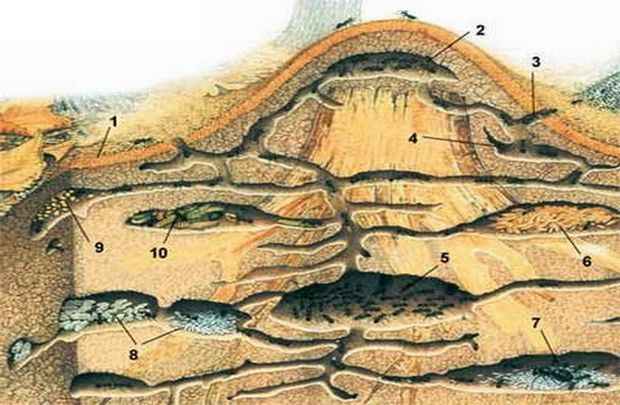

If the conditions in the house or apartment are favorable (heat, dampness, unsanitary conditions), then the number of ants increases rapidly. In this case, several new queen bees appear that are capable of reproduction, which enhances the possibilities for the development of the colony. These females do not form new colonies, but remain in the existing one. Of course, as the number of queens increases, the spread of ants around the house accelerates.
The "houses" of these insects are distinguished by their complexity and surprisingly well thought out structure. More than a million individuals can be in it at the same time. The anthill has several exits, each of which is guarded by "warriors", as well as a large number of "industrial" premises.
- There is a "cowshed" - a chamber for keeping aphids (an insect that ants breed and guard).
- The cemetery is a compartment for dead insects and various debris.
- Barns are places for storing supplies.Moreover, there are several types of barns: for "grain" (the seeds of plants collected by the reapers are stored here) and for "meat", where the brought caterpillars, flies or other insects are stored.
- Place for the uterus. The queen of the colony lives in her own room, her main task is to lay eggs. Special workers take care of it.
- Finally, there are chambers with offspring, where the larvae, pupae, eggs and workers watching them are located.
Indeed, the structure of the dwelling of an insect colony is striking in its logic.
Despite the "greenhouse" conditions, in laboratory conditions, ants usually do not exhaust their full potential for life expectancy. How many years do ants live with an experienced amateur? This again depends on the species, but both the uterus and the workers have every chance to live 70-80% of the maximum. But the essence of the ant farm is to maintain the colony, and beginners usually make mistakes that lead to its rapid extinction.
By the way
It will turn out from a fertilized egg to a worker or a uterus, largely depends on nutrition. So, by the nature of food and its intensity, workers regulate the appearance of representatives of certain castes, which often differ in appearance.
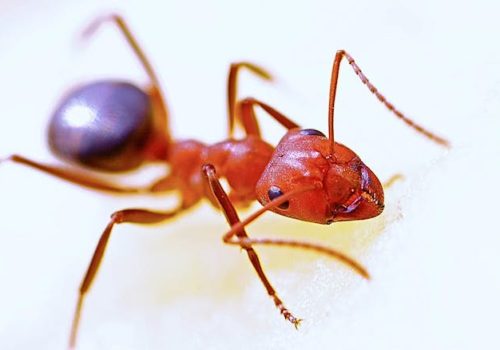

If the death of the only queen is allowed, without a queen, the workers will live their full potential, but the number of the colony will gradually decline, because new workers will not appear. There is a chance that workers will be able to grow a new queen from the remaining eggs, but they are small, so in the vast majority of cases, colonies left without a queen are slowly dying.
So, starting a pest control or choosing the optimal type of ants for an ant farm, do not be lazy to find out how ants reproduce and how long they live in order to avoid disappointment. In the first case, this will help to build the correct strategy for solving the problem, but in the second, it will not foolishly ruin the colony, on the cultivation of which you spent so much effort.
Diagram of the structure of the anthill in section with the designation of functional chambers. Ant colony structure.
Most often there are dome-shaped anthills, but sometimes ants prefer to settle in rotten tree trunks, large old stumps. In regions with extremely hot climates (for example, deserts), insects build their homes exclusively underground.
From the inside, the anthill looks different, but the structure of the allocation and organization of specialized chambers is characteristic of any nesting place of ants.
Indoor cameras can be divided into the following categories:
- "Solarium" - a small chamber under the very dome of the anthill, insects bask in it in the warm season;
- "Wintering chamber" - located below the soil level, in it the ants survive the cold, plunging into suspended animation;
- "Royal chamber" or "queen's room" - here is the uterus, which is engaged in laying eggs;
- "Grain barn" or "granary" - intended for storage of seeds of herbs and trees;
- "Kindergarten" or "nursery" - chambers in which eggs ripen and ant larvae are born;
- "Meat pantry" or "refrigerator" - they store the corpses of insects, worms and caterpillars.
- "Cowshed" - where the ants keep and raise aphids.
- A “cemetery” is a place where waste and deceased individuals are located. It is significantly removed from the anthill, since the ants understand that corpses and waste are a source of disease and infection;
We suggest that you familiarize yourself with How to protect a fur coat from moths at home
Ant society
But do not forget that workers can be busy with affairs of different levels of danger. So, if an ant mainly watches pupae and larvae, digs tunnels or is responsible for storing food, then the chance of living its full potential is higher. And if an individual defends an anthill or is a forager that delivers food to the family, then it may not live for several months.
By the way
Working ants are almost always females with a depressed reproductive system. In the event of the death of the uterus, they can also lay eggs, but in most cases, like in reapers, only males will emerge from such eggs, since the eggs are not fertilized.
When it comes to males, their fate is unenviable. In fact, they are born only in order to fertilize the uterus, and after that there is no need for them. Nature has allocated them unfairly little time: usually it is several weeks, and in some species even less. But males, unlike workers, have wings, if this can be considered a consolation at all. It is in the mating flight that the fertilization of the uterus is carried out, which is the only purpose of the existence of drones.
These insects are distributed almost all over the world, they are absent only in territories covered with eternal glaciers and in the oceanic expanses. They learned to adapt in an amazing way to the most difficult living conditions, even the deserts and cold northern regions were no exception.
To build an anthill, you can use:
- wood;
- cavity in the ground;
- human dwelling.
Sometimes hardworking insects build their own home on their own. Where ants live depends on their species. For example, blacks prefer to build a dwelling in the ground or in rotten wood. Redheads make anthills under rocks or trunks of trees blown out by the wind. Forest houses build impressive mansions, which can be more than 2 meters in height.
By the way
On the one hand, these small insects cause sympathy for their hard work, however, many gardeners and gardeners have been trying unsuccessfully to fight them for many years.
Ants live in colonies, within which responsibilities are clearly distributed, and often choose a place important for humans for their anthill.
You can destroy the dwelling of harmful insects in the garden with the help of a simple folk remedy: mix 5 liters of water with vinegar, sunflower oil and liquid soap (1 glass of each component), pour this mixture on the anthill. After it is covered with plastic wrap for a day. Most of the insects, including the uterus, will be exterminated.
A clear hierarchy reigns within the colony, all responsibilities are strictly distributed. Insects belong to the public group and are clearly divided into three castes:
- uterus (she is always alone);
- working individuals;
- males.
Each caste has its own functions, the failure to fulfill which is unacceptable.
The VredStop resource did a little research and found out that there are slave owners among ants: they kidnap larvae from anthills of other colonies and raise them as slaves doomed to do the most difficult work all their lives.
How long an insect will live depends on what species and caste it belongs to in the ant community. In addition, the physical data of the ant is also important: the larger the individual, the longer it can live.
The most common species. They are called the orderlies of the forest. One "ant house" cleans an area of one hectare from various harmful insects. The anthill of forest orderlies reaches quite large sizes - up to two meters in height. Woodland ants have a lifespan of approximately five years, but in reality, almost none of them live that long.
The queens live the longest, because they almost never leave the "home" and are engaged only in offspring. Ants-"hard workers" outside the anthill become victims of the attack of birds and do not have time to live the time allotted to them. Males live least of all, they die a month after fertilization of the uterus. Most of them do not even live this period - they die in the struggle for the female's favor.
Meadow ant
The main difference between this species and the rest is the presence of characteristic villi on their body.Meadow representative of ants is known to every person. They usually build their anthill in the field or in the garden. Meadow queens have wings and they fly out of their shelter twice a season to fertilize. This species also does not live for five years. Insects that spend a significant part of their life in a home have a better chance of a long life.
Pharaoh ant
Quite an interesting species that lives in most cases in warm countries. Since they love warmth very much, they choose a person's dwelling as their place of residence. In it, they do not build an anthill, but settle in cracks, cavities and cracks, and feel great. What is their lifespan:
- Females - from 7 to 9 months;
- Males - fertilizers - about a month;
- "Hard workers" - about two months.
Black garden ants settle in equipped nests in the ground. They can often be seen on a dirt road. In addition, insects choose rotten trees, secluded places under pebbles as a dwelling. Unlike other species, black garden ants create their house in depth, and not in height. Their theoretical lifespan is three years, but in reality no one lives that much. The ant population is completely renewed every year.
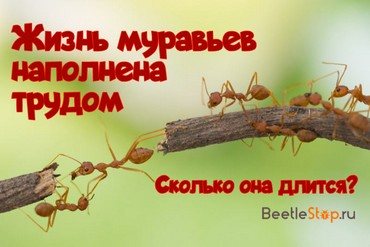

It is rather difficult to answer this question exactly, it all depends on the species. The average duration is 12 to 20 years. The life of a queen ant is a hundred times longer than that of other individuals.
Insects live on almost all continents, in all natural areas and climatic zones. They cannot be found in the Arctic and Antarctica, on the islands of Greenland and Iceland, as well as in sultry deserts. Ant representatives create anthills in rotten or rotten wood, in the ground and under small pebbles.
Some species are occupied by other people's dwellings. House ants prefer kitchens, dining rooms and bathrooms. They equip their nests under parquet, behind tiles, behind a baseboard, in various crevices and cracks. They quickly spread throughout the room, sneak into other buildings through various communication systems.
Ants can be found almost anywhere in the world, except for Greenland, Iceland, the Arctic and Antarctica. They managed to master almost all climatic zones of our planet. But regardless of their place of residence, the anthill of these insects is a complex structure capable of containing eggs and larvae in ideal conditions for them.
Conquerors of the globe
These insects are the real conquerors of the Earth. Today, almost 14,000 species of ants live in nature. Of these, several hundred subspecies live on Russian territory.
The number of representatives of the ant population is incalculable. They always live in families or, as they are also called, in colonies. Individuals simply cannot exist separately. Numerous ant colonies are found all over the world. They can be found everywhere:
- in forests;
- in the steppes;
- in the deserts;
- on ordinary city and village streets.
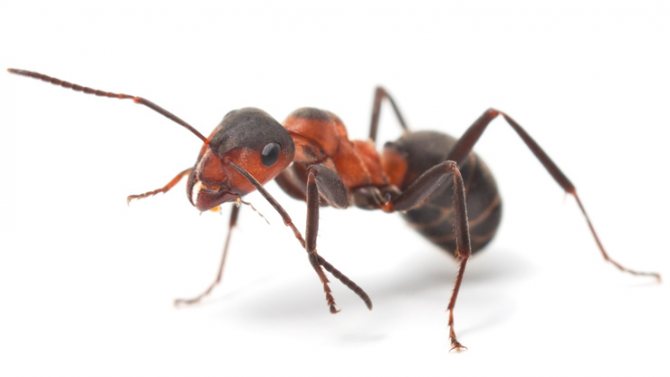

Different species of ants can be found in different habitats.
They even got to the permafrost zone. Most subspecies live in natural conditions, but there are those who live in human dwellings - houses and apartments.
The only corners of the planet where ants have not yet settled, while they remain:
- Antarctica;
- Greenland;
- some oceanic islands.
In this video, you will learn the lifespan of different species of ants:
Insect development
These representatives of the insect world have a complete transformation cycle and, accordingly, go through 4 stages of development.
- The uterus lays a huge number of eggs - this is the first stage.
- When the incubation period ends, a larva emerges from the egg, which outwardly does not resemble an adult, but rather looks like a worm. The main task of this stage of ant development is active nutrition and rapid growth.
- The next step is the chrysalis. The larva stops feeding; under optimal conditions, pupates in about two weeks.
- The imago (adult insect) emerges from the cocoon at about the twelfth day. Young ants practically do not differ from their older counterparts, only they are small in size and lighter in color.
We suggest that you familiarize yourself with How to deal with ants in an apartment
This is the scheme for the development of these inhabitants of the colony, the whole process described takes no more than a month.
The term and characteristics of the life of each representative of the ant colony in many ways depend on what functions it performs. So, the uterus is always one, it is she who reproduces working individuals and is distinguished by longevity. Males play only one role - fertilization. Having fulfilled their functions, they become unnecessary colonies and perish. Finally, workers are, of course, very important, but there are always a large number of them, therefore, the life span is short.
The life expectancy of the inhabitants of the colony is largely determined by their species.
- Pharaoh ants: working individuals - no more than 60 days, producers - 20 days.
- Tropical bulldog ants: workers - up to 5 years, uterus - up to 20 years.
- The red forest ant is genetically predisposed to a five-year existence, but in nature it dies more often, becoming a victim of a bird of prey or an unfavorable environmental factor.
- Black garden ants can theoretically celebrate three years, but in nature, their lifespan is reduced to a year.
As you can see, in real conditions, not all insects manage to live a genetically programmed number of years.
Ginger forest ant (Formica rufa)
This insect is called the orderly of mixed forests, since the inhabitants of a large anthill are able to clear an entire hectare of forest from various pests. Ants collect thousands of pupae of harmful insects throughout the day, which then go to feed the ant larvae.
Genetically, the life expectancy of the red forest ant is limited to 5 years, but in practice they die much earlier than the time measured by nature. Most often, they become prey for birds. Males, after fulfilling their main function, die within a month. The queen can be a long-liver if she stays in the nest permanently.
Anthill device
The depth of an anthill underground can reach up to 2 meters and has an organized complex structure. And the above-ground part can be from 30 cm to 2 m high. All this looks like a huge city.
The depth and structure of an ordinary anthill is amazing. The interior of this amazing structure consists of large fragments of branches. Between them are many galleries leading to individual chambers, which is a rather complex device.
The height of the structure varies from 30 cm to 2 m, the underground part most often exceeds the surface area. The outer covering consists of small twigs, needles, grains of sand and reliably protects ants from moisture, wind and cold. The structure of the underground anthill of the garden ant is similar to the forest ant, but on the surface it is only a small sandy mound.
The underground part, as a rule, is comparable, and more often exceeds the above-ground part in size. In places where there are large reserves of resources for ants (water, grasses, insects of other species), dwellings can reach gigantic proportions. In some cases, the population of a colony can exceed, imagine, 1.5 million individuals.
The anthill is arranged in an interesting way: up to a third of the working ants continuously move the needles and branches! Why are they doing this?
The anthill is arranged in such a way that a positive temperature (26-29 degrees Celsius) is constantly maintained inside, which is very important for ants. For this purpose, the needles and branches from the bottom layer of the coating are transferred to the surface, ventilated and dried.
This process is continuous, with about a third of the worker ants participating in it.Thanks to their efforts, favorable conditions are created for the development of larvae and the preservation of food reserves.
House ants: why get turned on and how to get rid of them?
Ants enter an apartment or private house in search of food or shelter from the cold and rain. You need to start the fight with them by finding a nest. It is there that you can find an ant family. Ant control should include the following steps:
- pour boiling water over the nest, while taking into account that the water is unlikely to reach the uterus;
- clean up the home and treat all surfaces with a disinfectant;
- patch up all cracks and cracks in the floor and walls;
- treat ant paths with anticancer gel (Kombat, Global, FAS, Dohlox), spray a spray near the anthill (Raptor, Raid, Dichlorvos) or place traps in places where parasites accumulate.
Loading ...
Queen of ants
The queen of ants is the uterus - a sexually mature female. She needs wings, in fact, only in order to find a male. Males and females of ants fly rather badly. Ants are not able to take off directly from the ground. They rise gradually, first flying up onto blades of grass, then onto the branches of bushes, then trees, and only then, from a sufficient height, they begin to fly. However, some drones are capable of taking off directly from the ground.
After fertilization, the female sheds her wings - she no longer needs them. The queen is able to establish a new anthill. To do this, she pulls out a small underground corridor, where she subsequently lays eggs. Sometimes a colony is organized by several females at once. After that, a difficult period begins in the life of the uterus.
Hierarchy
In any anthill, there are three categories of insects: the queen, male drones, and worker ants. Males emerge from eggs that have not been fertilized. Their main role is participation in reproduction and fertilization. They need wings for the mating flight. They differ from worker ants in body size.
Worker ants are the backbone of an anthill's strength. They bear all the economic responsibilities of the colony.
The queen is a sheer colossus compared to a worker ant. She first has wings, and then, after mating flight and fertilization, bites them off, becoming "non-flying". All her further life is devoted to laying eggs and procreation. "Ant queens" (queens) under favorable conditions can live up to 5 years (in some species and longer).
Tropical ant (Myrmecia gulosa)
Tropical ants can be called centenarians, in bulldog ants, the uterus does not live 12 or 6 years, but about 20-22 years, working individuals live up to 5 years.
As entomologists note, the average life cycle is:
- Worker ants are 1 to 3 years old. Moreover, the lifespan of large individuals is longer than that of small ones, and ants - inhabitants of cold regions live less than their counterparts in the tropics
- In males, the life cycle is limited to a few weeks. Their life purpose is to participate in mating, and then they are destroyed by the ants of their anthill or become the prey of predators. Some species keep males alive, but only if there are several queens in the anthill.
- The uterus can live for about 20 years, which exceeds the life span of an ordinary working ant by 10-15 times. During this time, she is able to give offspring of 500,000 or more.
Some interesting facts
- Some of the species of these arthropods can be under water without air access for 4 days, as if in a conserved state. Extracted from the liquid, they come to life again and continue to exist.
- The legs of the ant (there are 6 of them, and each has 3 joints) are very strong. They are, as it were, designed by nature for hard work and moving loads.By the way, if this insect was as tall as people, then in proportion to physical data it could run at a speed of up to 60 kilometers per hour and lift loads of one and a half tons!
- Ants, according to some researchers, have a collective intelligence, and the total number of their brain cells (for a single anthill) is comparable to the number of the same cells in humans.
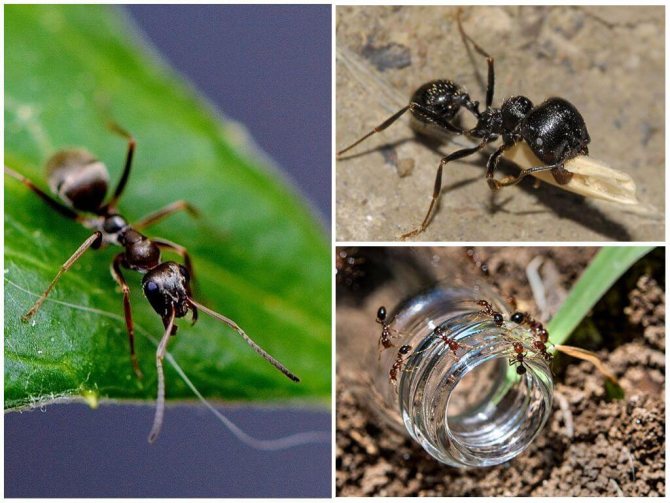

Ants
The lifespan of insects is influenced by climatic factors, the amount of food, living in artificially created conditions.
- Ants can live without food in an anthill theoretically for about 6 months. Since inside the structure of their nest there are numerous chambers with food supplies. ... Insects feed on the juices of plants, berries, fruits, caterpillars, dead beetles, leaving them without food is possible only in artificially created conditions. In this case, the ants will die within 2 weeks.
- Insects also live in an apartment for a long time, if a person does not declare a cruel war on them. However, this condition applies to "unexpected guests" with a full-fledged family. If artificial conditions for the existence of this insect are created, the insect lives without an anthill for no more than 3 months. If the house is not properly equipped, there is no hierarchical structure of "society".
- In countries with harsh climates, ants have to spend the winter and sleep most of their lives - 9 months. Therefore, the total life expectancy for 3 years is barely equal to the life expectancy of representatives of tropical countries for 12 months.
All values are averaged, since many factors affect the lifespan of an ant.
Pharaonic ant (Monomorium pharaonis)
Pharaonic ant, brought from hot habitats, settles and lives in people's homes. In an apartment, these insects do not build an anthill, but choose separate niches and cavities for their habitat. If pharaoh ants settle in an apartment building, then the number of their colony can reach several thousand individuals, and they will all belong to the same family.
These insects have the shortest life cycle. Females usually live no more than 9 months, breeder males are given about 20 days, and working individuals - no more than 2 months. Despite their short existence, insects are able to reproduce at least 30,000 individuals during this period, which occurs due to the presence of a large number of queens in the nest.
We suggest that you familiarize yourself with How long domestic cockroaches live without a head, red Madagascar without eating water
Relationship and communication of ants
Among these small insects, there is also a kind of power struggle. For example, in colonies of red ants, cases of the capture of settlements of another species were observed. The queen-queen finds a colony of black or forest relatives weakened as a result of the attack and takes the place of the dead queen. Then she lays eggs, and when red ants hatch from them, they actually enslave a colony of another species.
In nature, the opposite situation can also be observed, when workers from neighboring anthills establish contact and exchange food. This is a kind of message to neighbors about peace and a proposal for unification into one colony.
This is how interestingly the anthill is arranged - this is an amazing structure with a complex organization, reminiscent of a big city. How much time and labor does this tiny insect cost to rebuild an ant colony, the aerial part of which is threatened at every moment by predators or natural phenomena.
Meadow ant (Formica pratensis or Messor Structor)
This species of ants prefer to arrange their home in meadows and forest edges. During the season, winged females leave the anthill twice for the purpose of fertilization. The lifespan of meadow and forest ant is the same.
Ants that rarely leave the nest have a longer life period than those that are forced to often go outside.The main cause of death of worker ants is the attack of predators, as well as high injury rates.

